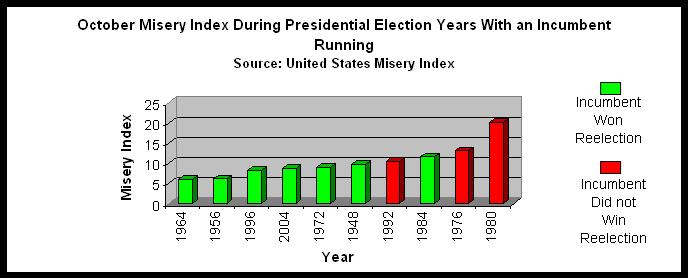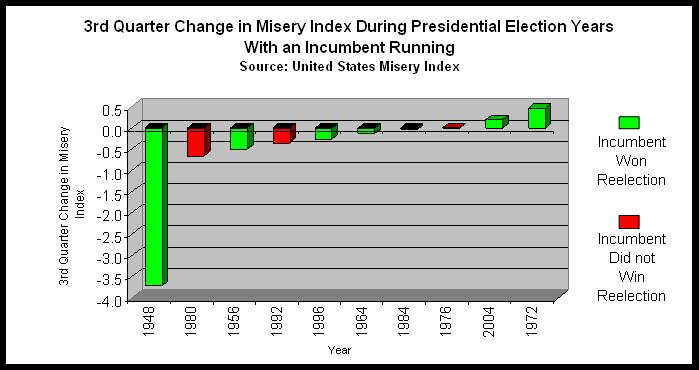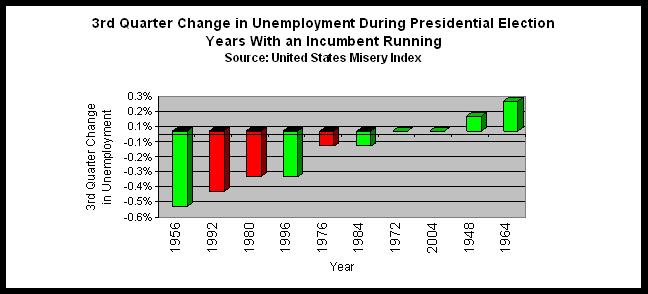Today saw two separate and seemingly contrasting assessments of the state of the 2012 presidential election. First, CNN released its latest presidential poll, and it showed Barack Obama leading Mitt Romney among a sample of registered voters by 52%-47%. Later, Fox News released its own survey showing Obama up among registered voters by 9%, 49%-40%, over Romney. At the same time as these generally favorable polls for Obama were released, political scientist James Campbell, in this guest column at Larry Sabato’s Crystal Ball, weighed in with his own assessment of the election that painted a distinctly different picture. Campbell analyzed two sets of numbers: second quarter GDP numbers in the election year, and GDP numbers for the last 10 fiscal quarters prior to the election in presidencies starting back to 1956 through the Obama administration, and correlated them with elections results. He found that by both measures the economy under Obama ranks near the bottom of the pack – a finding that, if history holds, does not bode well for Obama’s reelection chances. As Campbell writes, “If the election becomes largely a referendum on President Obama’s economic record, it is hard to see how he can win. As I have been setting it out in this essay, the record really speaks for itself. It is dismal, and this is without noting the 42 consecutive months and counting of an unemployment rate over 8%.”
How do we reconcile polls results such as those contained in the CNN and Fox surveys that show Obama ahead with the much more pessimistic forecasts by political scientists, such as Doug Hibbs, Campbell and even Alan Abramowitz, based on economic fundamentals? Bert Johnson and I touched on this topic in our latest professor pundits’ video, but I want to elaborate some of our comments here. In a scholarly article written in 1993, Gary King and Andrew Gelman examined why trial heat polls like CNN’s and Fox’s can be so volatile in the months preceding a campaign despite political scientists’ claim that election results are largely dictated by fundamental factors that do not change appreciably during the campaign season. The answer, they suggest, is that many voters who are surveyed several months before an election often really haven’t given much thought to who they will vote for, even though they respond to the question sincerely. That is, these survey respondents over estimate their own certitude regarding for whom they are likely to vote. But their answers this far out are often driven by short-term events, such as media coverage of a candidate’s “gaffe”, or more general perceptions regarding who is “ahead” in the race. These short-term factors, however, are not the ones that ultimately drive the decision for most individual voters. Instead, that decision will be rooted in the fundamentals, such as economic growth as measured by GDP, as interpreted through voters’ own partisan and ideological lens.
Although their research is dated, I don’t think King and Gelman’s conclusion are any less applicable today, which is why I caution against paying much attention to trial heat polls such as CNN’s and Fox’s at this stage of the campaign. This is even more so for state- level trial heat polls, which is why I am skeptical of efforts to predict the Electoral College vote this far out, particularly since many pollsters’ likely voter screens at the state level aren’t particularly accurate as yet. More generally, I don’t believe that the relative electoral fortunes of Obama and Romney are fluctuating as much as many voting models based on polling data suggest.
Now, as I have said many times before, when we get closer to the election these polls will become increasingly accurate and they should (fingers crossed!) converge with what the forecast models based on the fundamentals tell us should happen. Indeed, by the final weeks of the campaign, the polls will be much more precise than our fundamental-based forecast models. As of now, however, the fundamentals cast a gloomier outlook on the election for Obama than do today’s trial heat polls. How gloomy? Here, according to Campbell, is where Obama’s 2nd quarter GDP numbers rank among presidents dating back to 1952:

As you can see, only Carter had a worse election year second quarter. The story is not much better if we look at the average GDP growth for the last 10 quarters; here the GDP figures for Obama are better only than George H.W. Bush’s and the Nixon-Ford quarters.

Note that Campbell doesn’t actual present a forecast in this article. In past years, however, he has presented a forecast model in early September based on GDP 2nd quarter growth and Gallup Poll trial heat polls from Labor Day, and I expect he will do so again in a matter of weeks. In previous elections this model has done quite well predicting the winner’s share of the two-party vote. Like all forecast models, however, it is not foolproof; in 2008 Campbell was the only political scientist to my knowledge who forecast a McCain victory (with 52.7% of the two-party popular vote). Ironically, Campbell blames his failure to forecast Obama’s victory on one of those “black swan” events that political scientists always say can throw a forecast off, but which never seem to appear. In 2008, however, if Campbell is to be believed, it did appear in the form of the Wall St. meltdown. As Campbell wrote in his election post-mortem (gated): “Unlike any election in modern history, the 2008 campaign had been derailed by an entirely unanticipated and unpredicted external event.” But, given this unprecedented fiscal meltdown, why did the other forecast models successfully predict Obama’s victory and come much closer to estimating his share of the two-party vote? Campbell says, in essence, that they were lucky: “Under the circumstances, I think that whether a forecast was close to or distant from the vote this year is largely a matter of good or bad luck. Nothing in any of the models would have either directly or indirectly anticipated the effects of the timing of the Wall St. meltdown. Nothing.”
Not all forecasters would agree. As I noted in an this earlier post discussing Doug Hibbs’ forecast model, Hibbs has no use for models like Campbell’s that incorporate trial heat polls or presidential approval ratings because they are essentially adding “noise” the forecast, since both approval and trial heat results are themselves predicated, at least in part, on the economic fundamentals.
So where does that leave the race? In my view, the fundamentals that have generally proved reliable in the past suggest that come November, this race will be much closer than the margin suggested by today’s CNN and Fox polls. Although you will undoubtedly hear pundits proclaiming in the wake of these latest polls that we are seeing a potential turning point in the race, with Obama beginning to stretch his lead, the King and Gelman study reminds us that this type of polling volatility is par for the course and likely does not provide a very reliable preview of November’s outcome.




